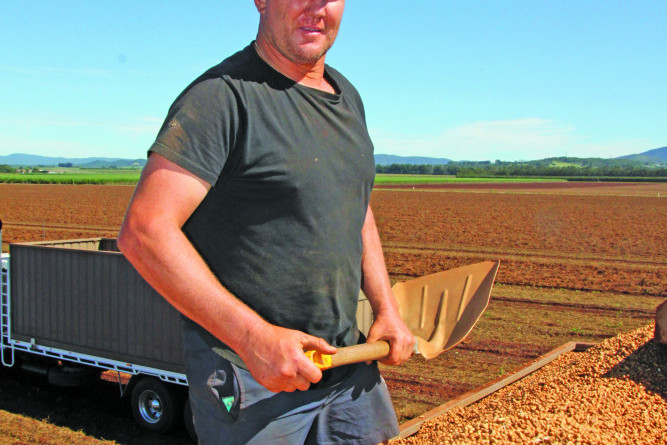Community & Business
6 June, 2021
Bumper peanut harvest underway on Tablelands
THE bumper peanut harvest currently underway on the Tablelands is set to re-establish the far north as the nation's leading producer of this delicious legume, according to Tolga Branch Manager of Peanut Company Australia, A Bega Company, Jenny Wenham.

BY SALLY TURLEY
THE bumper peanut harvest currently underway on the Tablelands is set to re-establish the far north as the nation's leading producer of this delicious legume, according to Tolga Branch Manager of Peanut Company Australia, A Bega Company, Jenny Wenham.
Clearly excited about this year's crop which had almost tripled in volume compared to the last few years, Ms Wenham said 2021 had delivered the almost perfect combination of moisture, heat units and clear harvest weather which were proving a win-win situation for growers.
“After a slight weather-related delay, our more than 40 growers are now fully into the harvest of their stand out peanuts. The quality of the 1700ha under crop is extremely good featuring jumbo kernels which are returning higher prices for farmers,” she said.
“We want Australia to know, we are back into the market place in a big way this year and will once again be able to supply the nation's demand for peanuts. This area produces almost half of the Australia's peanuts and growers received the ideal season to deliver volume and quality.”
Kairi farmer, Paul Pensini was hoping the weather was going to hold long enough for the harvester to finish threshing the 160 acres of peanuts he planted just after Christmas.
Mr Pensini said he hadn't grown peanuts for six or seven years, but the better price on offer combined with the boost in yield that peanuts provided to follow on crops in a rotational system, made them an attractive option this year.
Back in 2012, peanuts were worth around $2,300/Tonne before falling away to $1400 to an isolated $1900/Tonne over the following seven years, before climbing back to a high of $3,257/Tonne in April last year.
Although that April high had dipped to $2,585/Tonne by Dec of 2020, that rate was attractive enough to draw a large contingent of growers back into the peanut producing arena.
P3 Farms spokesman Paul Pensini said “last year's late wet meant a late plant just after Christmas, plants were fertilised and sprayed for fungicidal leaf diseases at planting.”
“It takes 4-5 months for a peanut plant to grow and they produce 25-50 peanuts per bush, when mature. Then there is only a small picking window before the pegs on the peanut shells weaken causing them to snap and be lost during harvest pick up," he said.
The Pensini's crop has been returning a healthy 2 - 2 1/2 tonnes/acre, but a 9" (225mm) fall just prior to harvest has had quite a dramatic effect on picking results.
The rich, red Golden Triangle soils can get quite sticky when wet and Mr Pensini said he had been losing from 15-20% of his peanuts during cutting and digging.
Peanuts can stick to the soil and be lost during this first stage of harvest when bushes are cut, lifted and shaken to remove excess dirt, before being inverted and left in windrows for 4-5 days to dry.
Once threshed, the nuts, which had been contracted to Bega (Peanut Company of Australia) were trucked to the Tolga depot for cleaning, shelling and bagging in 1 Tone bags, ready to be transported to Kingaroy.
Due to their peanut planting hiatus, most of the Pensini crop would be sold for seed.
“Because we planted into clean ground, there was minimal disease risk, making the crop suited to the seed buyers. What to plant is a year to year decision,” Mr Pensini said.
“We normally produce a lot of Rhodes Grass seed, but we are harvesting around 50 - 70 tonnes of Brachiaria seed at the moment and the same bins are needed to dry both seed species, so we have had to make a choice between the two.
“We are also baling Rhodes Grass hay at the moment. We normally bale 4-5000 of the big 500kg square bales for sale to Townsville, Charters Towers, Julia Creek and north to the Karumba live export yard when they were doing a lot of boats out of there.
“Unfortunately to a certain extent, Tableland farmers rely on the misfortune of western graziers to create big demand for hay and much of Queensland has had a better season this year,” he said.
Pensini's P3 Farms have been undergoing a bit of a company restructure recently with the sale of their coastal cattle block and their 34,500 acre breeder block, Ooralat Station, 40kms west of Mt Surprise, causing a reduction in stock numbers from 3,000 head down to 400.
Meanwhile, they have bought and are in the process of developing an additional 500 acres of country near Kairi, they run a general freight business between the Tablelands and Brisbane and harvest around 2-3,000 tonnes of potatoes each winter.
Looks like another pretty busy winter and spring ahead for the family.



